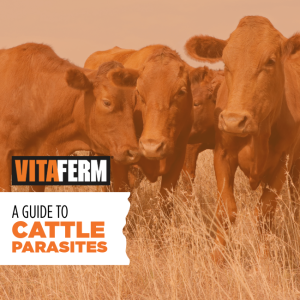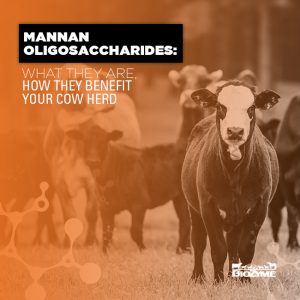
Calving time and scours. For many producers it seems the two go hand-in-hand. In a perfect world, producers would have ample calving space they could rotate to weekly with fresh, clean bedding in a protected environment away from Mother Nature’s wrath. That does sound good, the reality is most cow-calf operations don’t have that much space and use the same calving area for a 90-day period where they have shelter for the cows and their new babies.
No matter how often you clean your calving facility, the cause of scours – bacterial pathogens in the digestive system – goes unnoticed. And although there is no sure way to eliminate a pathogen invasion resulting in scours, there are ways to help prevent it.
“Good nutrition is key to supporting the immune system,” said Kevin Glaubius, Director of Nutrition at BioZyme® Inc.
Glaubius suggests a two-part program to keeping cows and calves at their optimal health. First, he said producers should add VitaFerm® Concept•Aid® 5/S MOS to cow diets 60 days prior to calving. Then, when the calves are born, create a creep area for the calves and include a 50-pound Vita Charge® Stress Tub with MOS.
For optimal results, Concept•Aid is typically recommended 60 days prior to calving. The Amaferm® in Concept•Aid is a natural prebiotic that is research-proven to increase the energy available to the animal resulting in more milk production as well as to the ability to initiate and maintain pregnancy and fertility. Adding the Concept•Aid with MOS will aid both the cow and her newborn calf’s nutrition and health in three key ways.
First, it helps reduce fecal shedding of the cow, keeping the area clean. Glaubius also recommends keeping gestating cows out of calving pen until calving time to help keep the area as clean and pathogen-free as possible.
Secondly, the MOS contains a high level of beta-glucans to help boost the immune system and help build a higher-quality colostrum, the only way immune defense the calf has immediately. MOS, is a sugar-protein complex that mimics compounds found in the digestive tract of the animal. Organisms attach to the MOS and get carried out of the calf instead of attaching to the cell wall of the digestive system where they multiple at a faster rate.
Third, the Concept•Aid contains elevated vitamin, mineral and trace mineral levels to help support reproductive health getting those females bred back. Those added vitamins and minerals also support the development of colostrum, crucial to the calves’ first nutritional intake.
When your first calves hit the ground, make a creep area for baby calves only, making sure to provide the area with a wind break, dry bedding and a 50-pound Vita Charge Stress Tub that only the calves can access. The Stress Tubs are a cost-effective way for the calves to get added nutrients. The palatability will attract the calves, and the height of the 50-pound tub makes it easier to access than a traditional mineral feeder. The calves will typically only consume about a .10 of pound per day, enough to get adequate MOS and Amaferm to help balance out the good and bad bacteria in its system.
“The challenge isn’t bacteria; its bad bacteria,” Glaubius said. “The animal relies on the healthy bacteria in its system. We don’t want to keep the gut sterile, we need to keep a balance of good bugs to bad bugs in check.”
Scours come in three primary forms – bacterial, nutritional and viral. The mode of action is targeted to bacterial, but its typically a combination of 2 of the 3 forms. Keeping nutrition top-of-mind and keeping a clean environment should help prevent scours.
“This program is not a cure-all for every type of scour. It won’t ensure you won’t have scours, but it will ensure that you are doing the best you can to prevent issues that lead to scours,” Glaubius said.
Make sure the calves have plenty of dry bedding, and put one 50-pound Stress Tub out for every 20-25 calves. Keep the tubs available to the calves until they are turned out to pasture in the spring time for maximum results. Keep cows on Concept•Aid MOS until grass turnout for maximum benefits. Then you can switch to Concept•Aid without MOS.
It’s not a perfect world, but with some planning, a clean environment and a sound nutrition program, scours at calving time can become one less challenge producers have to face.


